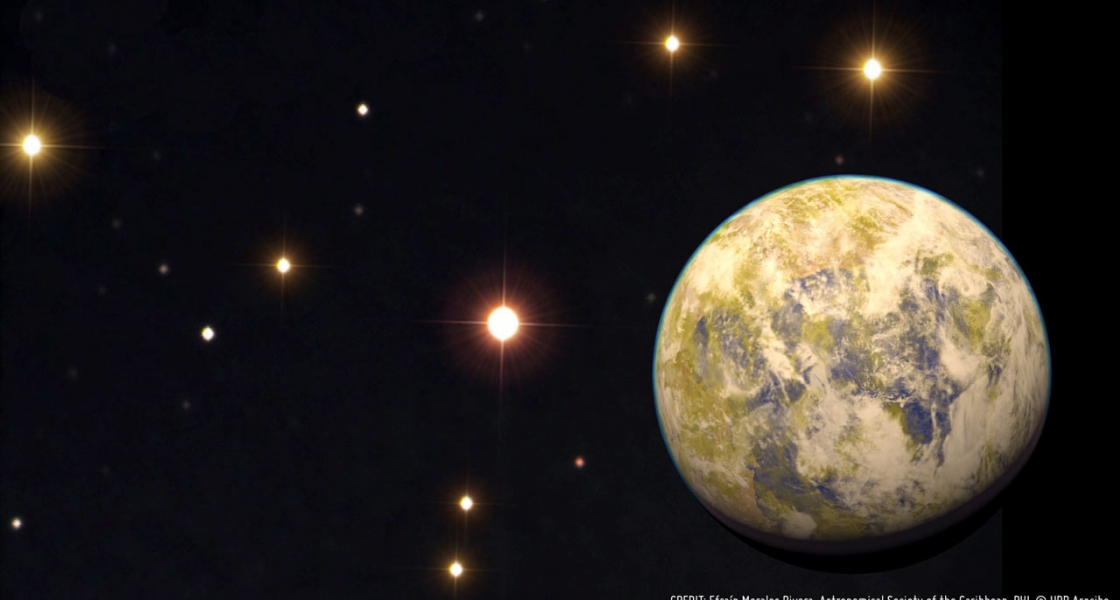Astrophysicist Jeff Linsky and his colleagues recently created a sophisticated mathematical model of the outer atmosphere of the small M-dwarf star called GJ832. The new model fits well with spectral observations of the star made with the Hubble Space Telescope (HST). This accomplishment bodes well for two reasons: First, it provides a tool for better understanding M-dwarf stars––the most common type of star in our galaxy. Second, it may aid in determining whether oxygen in the atmospheres of planets orbiting M-dwarf stars is produced by photochemistry or by living organisms such as green plants on Earth.
Astronomers have already discovered several thousand planets orbiting other stars, including two around GJ832, which is 16.1 light years away from Earth and one around Proxima Centauri, just 4.25 light years away. The planet orbiting Proxima Centauri, Proxima b, is just a little larger than Earth, and it orbits inside the “habitable” zone where liquid water could exist.
“Since the nearest star to the Sun has a rocky planet inside the habitable zone, then there’s going to be an enormous number of rocky planets in the habitable zones around other stars,” Linsky said.
Most stars in the galaxy are smaller, cooler M-dwarfs stars (including GJ832 and Proxima Centauri). Thus, it’s likely that the first habitable planets discovered in the next few years orbit M-dwarfs. For this reason, Linsky and his colleagues wanted to understand the spectra emitted by a typical M-dwarf star because a star’s light affects the atmospheres of the planets orbiting it [See sidebar]. The researchers chose GJ832 because it is relatively close to Earth, and the HST had already acquired excellent observations of its spectral characteristics.
What Linsky and his colleagues did was come up with a complete theoretical description of GJ832’s upper atmosphere, or chromosphere. The chromosphere is the origin of the radiation from the star that has been observed by the HST. The new model is so good that it can now be used to accurately predict the spectrum of an M-dwarf that cannot be directly observed.
The proof was in the pudding. The team was able to use their new model to accurately predict the observed UV spectrum of GJ832!––Julie Phillips
SIDEBAR: Stellar Radiation and the Evolution of Planets
Stellar radiation can affect planets in three ways: First, ultraviolet (UV) light from the star can photo-dissociate such molecules as water, carbon dioxide, and methane in the atmospheres of planets like GJ832 c. If a star emits lots of high-energy UV light and very little lower-energy UV light, then this radiation will produce oxygen in the atmosphere of exoplanets via chemical reactions alone.
Second, if there is lots of lower-energy UV light and very little high-energy UV light, then oxygen in a planet’s atmosphere may come from living organisms like plants on Earth (via photosynthesis) or from processes not yet understood.
Third, if there’s too much extreme UV or X-ray radiation coming from a star also producing a stellar wind, the result may be the complete loss of a planet’s atmosphere. Astrophysicist Jeff Linsky believes this may be the explanation for what happened to the atmosphere of Mars. Fortunately for our readers, Earth’s strong global magnetic field has long protected our planet from extreme radiation coupled to the solar wind. Mars, unfortunately, does not currently have a protective global magnetic field, although it likely had one in the distant past.



 The Physics Frontiers Centers (PFC) program supports university-based centers and institutes where the collective efforts of a larger group of individuals can enable transformational advances in the most promising research areas. The program is designed to foster major breakthroughs at the intellectual frontiers of physics by providing needed resources such as combinations of talents, skills, disciplines, and/or specialized infrastructure, not usually available to individual investigators or small groups, in an environment in which the collective efforts of the larger group can be shown to be seminal to promoting significant progress in the science and the education of students. PFCs also include creative, substantive activities aimed at enhancing education, broadening participation of traditionally underrepresented groups, and outreach to the scientific community and general public.
The Physics Frontiers Centers (PFC) program supports university-based centers and institutes where the collective efforts of a larger group of individuals can enable transformational advances in the most promising research areas. The program is designed to foster major breakthroughs at the intellectual frontiers of physics by providing needed resources such as combinations of talents, skills, disciplines, and/or specialized infrastructure, not usually available to individual investigators or small groups, in an environment in which the collective efforts of the larger group can be shown to be seminal to promoting significant progress in the science and the education of students. PFCs also include creative, substantive activities aimed at enhancing education, broadening participation of traditionally underrepresented groups, and outreach to the scientific community and general public.